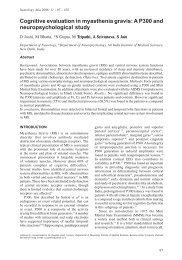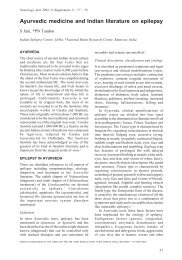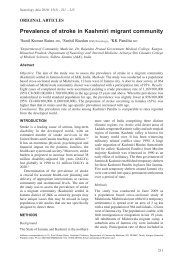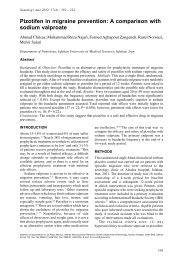Arranged marriage, consanguinity and epilepsy - Neurology Asia
Arranged marriage, consanguinity and epilepsy - Neurology Asia
Arranged marriage, consanguinity and epilepsy - Neurology Asia
You also want an ePaper? Increase the reach of your titles
YUMPU automatically turns print PDFs into web optimized ePapers that Google loves.
<strong>Neurology</strong> <strong>Asia</strong> 2007; 12 (Supplement 1) : 15 – 17<br />
<strong>Arranged</strong> <strong>marriage</strong>, <strong>consanguinity</strong> <strong>and</strong> <strong>epilepsy</strong><br />
MM Mehndiratta, B Paul, P Mehndiratta<br />
Department of <strong>Neurology</strong>, G.B.Pant Hospital, New Delhi, India<br />
Abstract<br />
<strong>Arranged</strong> <strong>marriage</strong> is where parents choose marital partners for their children. It is a norm in many<br />
parts of <strong>Asia</strong> <strong>and</strong> Middle East. A <strong>marriage</strong> is said to be consanguineous where the <strong>marriage</strong>s are<br />
solemnized among persons with close biological relations. There is considerable overlap in arranged<br />
<strong>and</strong> consanguineous <strong>marriage</strong>s with many cultures adopting both practices. Recent studies showed<br />
that there is significantly higher rate of <strong>consanguinity</strong> of parents of <strong>epilepsy</strong> patients. There is also<br />
significantly higher rate of <strong>epilepsy</strong> among family members with consanguineous <strong>marriage</strong> for both<br />
cryptogenic <strong>and</strong> idiopathic epilepsies.<br />
ARRANGED MARRIAGE<br />
<strong>Arranged</strong> <strong>marriage</strong> is defined as one where parents<br />
choose marital partners for their children <strong>and</strong><br />
arranged <strong>marriage</strong> is a norm in many parts of <strong>Asia</strong>,<br />
Africa <strong>and</strong> Middle East On the other h<strong>and</strong> non<br />
arranged <strong>marriage</strong>s are common in the Western<br />
part of the world. In the modern world there is<br />
co-existence of both types of <strong>marriage</strong> system.<br />
The total world population is around 6.5<br />
billion, <strong>and</strong> 3.7 billions (60%) live in <strong>Asia</strong>. On<br />
the other h<strong>and</strong>, Oceania region comprising of<br />
Australia, New Zeal<strong>and</strong>, Melanesia, Micronesia<br />
<strong>and</strong> Polynesia constitutes only 0.5% of the<br />
world population. In <strong>Asia</strong>, arranged <strong>marriage</strong> is<br />
particularly common in West <strong>and</strong> South <strong>Asia</strong>,<br />
Japan <strong>and</strong> rural areas in other parts of <strong>Asia</strong>.<br />
Thus, at least a third of <strong>Asia</strong>ns practice arranged<br />
<strong>marriage</strong>.<br />
<strong>Arranged</strong> <strong>marriage</strong> should not be equated<br />
with forced <strong>marriage</strong>, which may result in cases<br />
of much publicized tragedies. As the arranged<br />
<strong>marriage</strong> is usually by the parents, the choice of<br />
partners usually reflects the values of the parents.<br />
<strong>Arranged</strong> <strong>marriage</strong> may be particularly important<br />
where there is less opportunities for social<br />
interactions between the sexes of <strong>marriage</strong>able<br />
age. The divorce rate among South <strong>Asia</strong>ns that<br />
widely practice arranged <strong>marriage</strong> is low. The<br />
practice is thus compatible with stable families.<br />
A study was conducted on arranged <strong>marriage</strong>s<br />
<strong>and</strong> <strong>consanguinity</strong> in the department of <strong>Neurology</strong>,<br />
G.B Pant Hospital, a tertiary care University<br />
Hospital, New Delhi, India. A total of 300 subjects<br />
were interviewed, comprising of subjects (both<br />
inpatients <strong>and</strong> outpatients), their caregivers <strong>and</strong><br />
hospital staff. Seventy four percent were above<br />
30 years of age. Majority (77%) were men. The<br />
religions of the study subjects were: Hindu (75%),<br />
Muslim (22%), Sikh (2.5%) <strong>and</strong> Christian (0.5%).<br />
Education level was above 12 years in 61%.<br />
Seventy one percent were married. Most of the<br />
subjects interviewed (85%) had or were likely<br />
to have arranged <strong>marriage</strong>. The main reasons in<br />
favor of arranged <strong>marriage</strong> were to comply with<br />
the wish of the parents <strong>and</strong> to follow tradition.<br />
CONSANGUINITY<br />
A <strong>marriage</strong> is said to be consanguineous where<br />
the <strong>marriage</strong>s are solemnized among persons<br />
descending from the same stock or common<br />
ancestor with close biological relations. 1<br />
All human societies however primitive or<br />
geographically isolated prohibit the mating of first<br />
degree relatives, namely that between parents <strong>and</strong><br />
children <strong>and</strong> brothers <strong>and</strong> sisters, which is incest.<br />
Marriage between relatives less close than siblings<br />
or parents <strong>and</strong> offspring are not necessarily<br />
outlawed, but the dividing line between legal<br />
<strong>and</strong> illegal is hazy <strong>and</strong> varies between countries.<br />
In about one-half of USA, uncle-niece <strong>and</strong> auntnephew<br />
(second degree) <strong>and</strong> first cousins (third<br />
degree) mating are forbidden by law. In 1981<br />
Marriage of the People’s Republic of China,<br />
<strong>marriage</strong> between first cousin or closer was also<br />
prohibited. On the other h<strong>and</strong>, in India, <strong>marriage</strong>s<br />
between uncle <strong>and</strong> niece is legal. It has been<br />
reported that in Bangalore <strong>and</strong> Mysore, two major<br />
cities of Karnataka state of South India, 21% of<br />
Hindu <strong>marriage</strong>s were uncle-niece unions. 2<br />
Address correspondence to: Dr. M.M.Mehndiratta, Professor of <strong>Neurology</strong>, #502, Academic Block, Department of <strong>Neurology</strong>, G.B.Pant Hospital, New<br />
Delhi-110002, India. e-mail: mmehndi@hotmail.com<br />
15
<strong>Neurology</strong> <strong>Asia</strong><br />
Consanguineous <strong>marriage</strong> is particularly<br />
prevalent in Middle East, Pakistan, Muslims in<br />
India, Hindus in South India, Bangladesh <strong>and</strong> Sri<br />
Lanka, accounted for close to 50% of <strong>marriage</strong> in<br />
parts of Saudi Arabia <strong>and</strong> Pakistan. 3 It is also said<br />
to be common in parts of Japan accounting for 4%<br />
of <strong>marriage</strong>s in an all-Japan survey. 4 In China, it<br />
is prevalent in some minority populations such as<br />
Tajik <strong>and</strong> Uzbek in Xinjiang. It is also prevalent<br />
among the Middle Eastern, Indian <strong>and</strong> Pakistan<br />
diasporas in Europe <strong>and</strong> North America. 3<br />
The preference to consanguineous <strong>marriage</strong><br />
has been attributed to traditions, maintenance<br />
of family structure <strong>and</strong> property, strengthening<br />
of family ties, financial advantages relating to<br />
dowry, closer relationship between the wife <strong>and</strong><br />
the in-laws, greater social compatibility, greater<br />
<strong>marriage</strong> stability <strong>and</strong> durability. Higher rates of<br />
consanguineous <strong>marriage</strong> have been associated<br />
with low socioeconomic status, illiteracy, <strong>and</strong><br />
rural residence. 3<br />
A hospital based study from Pakistan showed<br />
high prevalence of consanguineous <strong>marriage</strong><br />
among the population. The preference for<br />
consanguineous <strong>marriage</strong> is reflected in the<br />
quotation, “in arranged <strong>marriage</strong>”, “it is healthy to<br />
marry within the family”. Constrains of religion,<br />
status, caste, family differences <strong>and</strong> the fear of<br />
incompatibility were among the reasons quoted as<br />
difficulties in finding a mate outside the family.<br />
Security of knowing the mate in the family, culture<br />
<strong>and</strong> religion, <strong>and</strong> having more information about<br />
the mate before <strong>marriage</strong> were quoted as reasons<br />
for the continued popularity of consanguineous<br />
<strong>marriage</strong>s in Pakistani population. 1,5,6<br />
RISK OF EPILEPSY AND OTHER DISEASES<br />
IN CONSANGUINEOUS MARRIAGE<br />
The detrimental health effects associated with<br />
<strong>consanguinity</strong> are caused by the expression<br />
of recessive genes inherited from a common<br />
ancestor(s). This probably applies to rare single<br />
gene conditions as well as to multigene disorders<br />
with multifactorial inheritance.<br />
Recent study in the State of Qatar showed<br />
rate of consanguineous <strong>marriage</strong> was 54% with<br />
confidence limits of 52.3 – 55.7%. Bronchial<br />
asthma, mental retardation, <strong>epilepsy</strong> <strong>and</strong> diabetes<br />
were significantly more common in offspring of<br />
the consanguineous than non- consanguineous<br />
couples. 7 Evaluation of stroke in children at<br />
King Khalid University Hospital, Saudi Arabia<br />
showed that children with recurrent strokes were<br />
significantly more likely to be the product of<br />
consanguineous <strong>marriage</strong>s (P=0.04). 8<br />
16<br />
2007; 12 (Supplement 1)<br />
In unrelated mating the probability of<br />
producing a child with a serious birth defect or<br />
mental retardation is 3 - 4 %. This figure doubles<br />
in first cousin mating <strong>and</strong> trebles in uncle - niece<br />
<strong>and</strong> aunt - nephew <strong>marriage</strong>. A recent review<br />
reported an increase in incidence of birth defects<br />
for first cousin progeny of 0.7 to 7.5% as compared<br />
to non-consanguineous couples, with the higher<br />
values recorded in more recent studies. 9<br />
As for risk of <strong>epilepsy</strong> from <strong>consanguinity</strong>,<br />
a study was done in Iran on 181 children <strong>and</strong><br />
adolescents up to the age of 18 years with<br />
<strong>epilepsy</strong> over a 6 months period. The percentage<br />
of <strong>consanguinity</strong> in parents of the <strong>epilepsy</strong><br />
patients was significantly higher in comparison<br />
to the general population (OR 2.6, 95% CI: 1.9-<br />
3.5, P
There is no doubt social <strong>and</strong> economic benefits<br />
from consanguineous unions, <strong>and</strong> the undesirable<br />
clinical outcomes of close kin <strong>marriage</strong> affects<br />
only a minority of families <strong>and</strong> individuals. 3 With<br />
the smaller size family from improving level of<br />
education, socioeconomic conditions <strong>and</strong> higher<br />
age of <strong>marriage</strong>, a decline in the prevalence of<br />
close consanguineous union can be predicted.<br />
Nevertheless, the undesirable biological effect<br />
of close kin <strong>marriage</strong> is significant.<br />
The main thrust towards a reduced frequency<br />
of consanguineous unions remains in the field<br />
of preventive genetics in the form of general<br />
education of society. The public education may<br />
have to be taken at school level during adolescence<br />
to instill the biological risk of close <strong>marriage</strong>s.<br />
Parents must be aware of the close associations of<br />
their children with the children of their brothers<br />
<strong>and</strong> sisters during their adolescence. Pre-<strong>marriage</strong><br />
counseling for couples who have a family history<br />
of <strong>epilepsy</strong> <strong>and</strong> preconception counseling for<br />
those with consanguineous <strong>marriage</strong> will facilitate<br />
informed family planning.<br />
REFERENCES<br />
1. Hussain R, Bittler AH. The prevalence <strong>and</strong><br />
demographic characteristics of cnsanguineous<br />
<strong>marriage</strong>s in Pakistan, J. Biosoc. Sci. 1998;30:261-<br />
75.<br />
2. Bittles AH, Shami SA, Appaji Rao N. Consanguineous<br />
<strong>marriage</strong> in Southern <strong>Asia</strong>: incidence, causes <strong>and</strong><br />
effects. In: Bittles AH, Roberts DF, eds: Minority<br />
populations: Genetics, demography <strong>and</strong> health.<br />
London: Macmillan, 1992: 102-18.<br />
3. Bittles AH. Empirical estimates of the global prevalence<br />
of consanguineous <strong>marriage</strong> in contemporary<br />
societies. Centre for Human Genetics. Edith Cowan<br />
University, Western Australia <strong>and</strong> Morison Institute<br />
for Population <strong>and</strong> Resources Studies, Stanford<br />
University, California. www.stanford.edu/group/<br />
morrinst/pdf/MorrisonPN0074.pdf<br />
4. Imaizumi Y. A recent survey of consanguineous<br />
<strong>marriage</strong>s in Japan. Clinical Genetics 1985; 30:<br />
230-3.<br />
5. Hussain R. The effect of religious, cultural <strong>and</strong><br />
social identity on population genetic structure among<br />
Muslims in Pakistan. Ann Hum Biol 2005; 32(2):<br />
145-53.<br />
6. Waris Qidwai, Iqbal Azam Syed, Faisal M Khan.<br />
Prevalence <strong>and</strong> perceptions about consanguineous<br />
<strong>marriage</strong>s among patients presenting to family<br />
physicians, in 2001 at a Teaching Hospital in Karachi,<br />
Pakistan. <strong>Asia</strong> Pacific Family Medicine 2003; 2:<br />
27.<br />
7. Bener A, Hussain R. Consanguineous unions <strong>and</strong><br />
child health in the State of Qatar. Paediatr Perinat<br />
Epidemiol 2006; 20(5): 372-8.<br />
8. Salih MA, Abdel-Gader AG, Al-Jarallah AA, Kentab<br />
AY, Al-Nasser MN. Outcome of stroke in Saudi<br />
children. Saudi Med J 2006; 27 (Suppl 1): S91-6.<br />
9. Zlotogora J. What is the birth defect risk associated<br />
with consanguineous <strong>marriage</strong>? Am J Med Genet<br />
2002; 109: 70–1.<br />
10. Asadi-Pooja AA. Epilepsy <strong>and</strong> <strong>consanguinity</strong> in<br />
Shiraz, Iran. Eur J Paediatric <strong>Neurology</strong> 2005;<br />
9(6): 383-6.<br />
11. Ramasundrum V, Tan CT. Consanguinity <strong>and</strong> risk of<br />
<strong>epilepsy</strong>. Neurol <strong>Asia</strong> 2004; 9 (Suppl 1): 10-11.<br />
17







